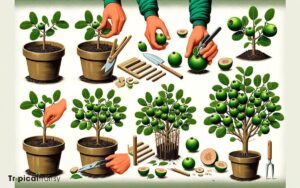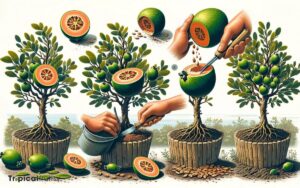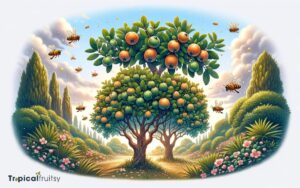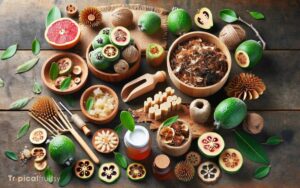Are Feijoa and Guava Related? Yes!
Yes, feijoa (Acca sellowiana) and guava (Psidium guajava) are related; they both belong to the Myrtaceae family, which makes them botanical cousins.
Despite their relationship, they feature distinct flavors and nutritional profiles, with feijoas offering a minty-pineapple taste and guavas providing a tropical sweetness.
The Myrtaceae family includes various species that are often characterized by aromatic leaves and flowers.
Feijoa and guava are two such species within this family. They are:
Both fruits are rich in Vitamin C and dietary fiber, but they have adapted to different climates and have unique taste profiles.
Exploring the shared heritage of feijoas and guavas provides insight into the diverse Myrtaceae family and enriches our culinary palette.
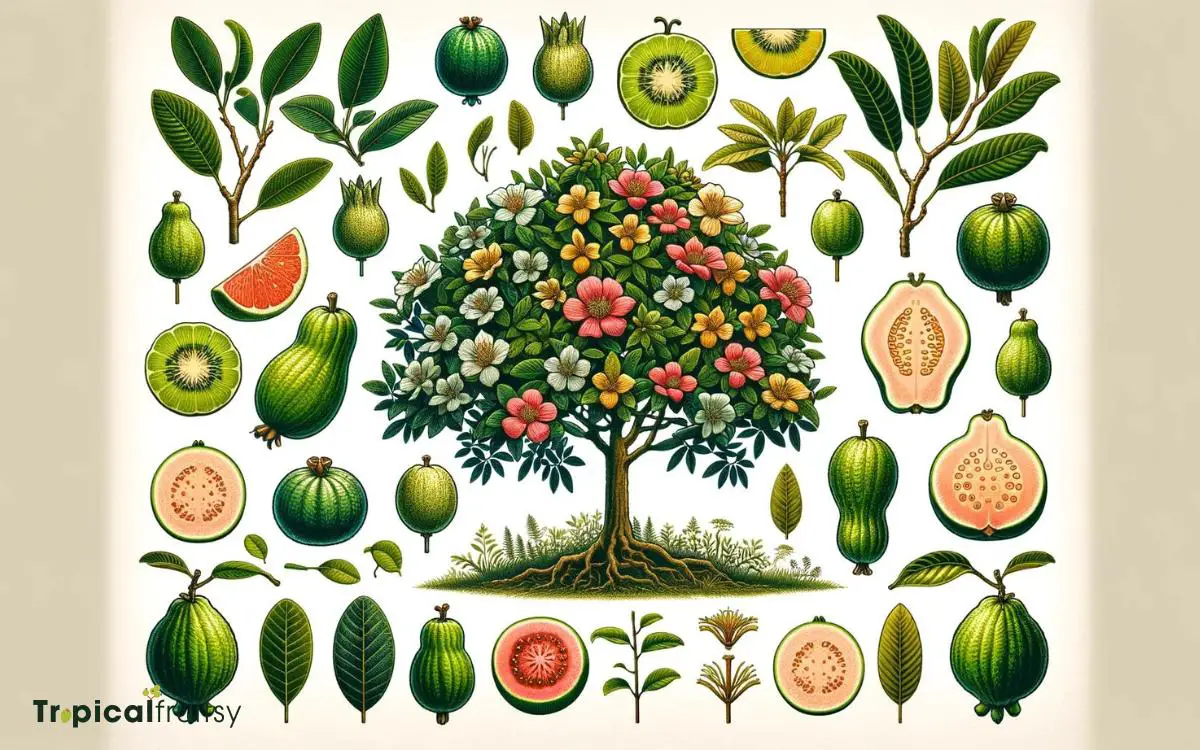
Key Takeaway
5 Characteristics Of Feijoa And Guava
| Characteristic | Feijoa (Acca sellowiana) | Guava (Psidium guajava) |
|---|---|---|
| Family | Myrtaceae | Myrtaceae |
| Native Region | South America | Tropical Americas |
| Climate Adaptation | Cooler subtropical | Tropical and subtropical |
| Flavor Profile | Minty-pineapple | Tropical sweetness |
| Main Nutrients | Vitamin C, Fiber | Vitamin C, Fiber |
Origins of Feijoa
Originating from the highlands of South America, feijoa is a fruit-bearing shrub that belongs to the Myrtaceae family. It’s scientifically recognized as Acca sellowiana and shares taxonomic kinship with the guava, hinting at their relational proximity.
Feijoa’s introduction to different regions beyond its native habitat, including New Zealand, has expanded its cultivation, highlighting its adaptability to diverse climatic conditions.
The shrub thrives in subtropical environments with mild winters, a factor critical to its successful propagation.
Researchers have noted its unique pollination system, reliant on birds and insects, which ensures its reproductive success and contributes to genetic diversity.
The fruit’s distinctive flavor profile and nutrient composition make it a subject of interest in both culinary and nutritional sciences.
Guava’s Botanical Background
Guava belongs to the Myrtaceae family, which encompasses a wide range of aromatic plants and trees. Its species classification, falling under the genus Psidium, marks it as distinct from feijoa within the same botanical family.
The native habitat zones of guava span tropical and subtropical regions, contributing to its particular ecological and physiological characteristics.
Family: Myrtaceae
Belonging to the Myrtaceae family, guava shares a botanical lineage with several other aromatic plants and trees, including the feijoa.
This family is characterized by a range of features that are important from a taxonomic perspective:
- Diverse Genera: Myrtaceae encompasses over 130 genera and more than 4600 species, exhibiting considerable diversity.
- Distribution: The family has a pantropical distribution, with some members also found in temperate regions.
- Economic Value: Various species within this family have significant economic value, providing fruits, timber, and essential oils.
- Morphological Traits: Typically, they possess leathery leaves with oil glands, and their flowers usually display numerous stamens.
The analysis of Myrtaceae reveals that both feijoa and guava exhibit these familial characteristics, underlining their relatedness within this botanical grouping.
Species Classification
How does the guava’s botanical classification further demonstrate its connection to the feijoa within the Myrtaceae family?
Guava, known scientifically as Psidium guajava, is a species that shares the Myrtaceae family with the feijoa (Acca sellowiana). This taxonomic relationship is pivotal, as it underlines a common phylogenetic lineage.
Both species exhibit characteristic traits of Myrtaceae, such as essential oils in their leaves and a similar flower structure, with numerous stamens and a superior ovary.
The genus Psidium comprises about 100 species, including the guava, and is characterized by its tropical fruit-bearing trees and shrubs.
The close genetic kinship they share with feijoa is evidenced by their parallel evolution and shared morphological characteristics, affirming the guava’s botanical affinity with feijoa.
Native Habitat Zones
In addition to sharing a family tree with feijoa within the Myrtaceae, the guava thrives naturally in the tropical climates of Central and South America.
Its native range encompasses diverse ecological zones, which can be described as follows:
- Rainforests: Guava trees flourish in the humid and warm conditions of tropical rainforests.
- Coastal regions: The species is often found in sandy soils close to seashores, tolerating saline environments.
- Riverbanks: Proximity to water bodies provides the moisture necessary for guava trees to prosper.
- Mountain foothills: Some guava varieties have adapted to the cooler, yet still mild climates found at higher elevations.
These habitats contribute to the guava’s extensive genetic diversity, a topic closely tied to its taxonomic classification.
Taxonomic Classification
Taxonomic classification provides a framework for examining the relationship between feijoa and guava. It’s essential to assess family similarities to ascertain their degree of kinship.
The analysis then narrows to genus distinctions and species identification to pinpoint specific differences.
Family Similarities
Feijoa and guava are related through their membership in the Myrtaceae family, which classifies them as close botanical relatives. This taxonomic family comprises a diverse group of flowering plants, distinguished by several unifying characteristics.
To elucidate the connection between feijoa (Acca sellowiana) and guava (Psidium guajava), consider the following aspects:
- Genera: Feijoa and guava belong to different genera within the Myrtaceae family, suggesting divergence in their evolutionary paths despite common ancestry.
- Floral Structure: Both exhibit a typical Myrtaceae floral organization, characterized by numerous stamens and petals that are often showy.
- Leaf Morphology: The plants share similar leaf features, such as opposite leaves with oil glands, which are common in the family.
- Fruit Type: They produce fleshy, edible fruits that conform to the berry classification, typical of the Myrtaceae family’s reproductive strategy.
Genus Distinctions
Both feijoa and guava are distinct members within the Myrtaceae family, each belonging to their respective genera, Acca and Psidium.
The genus Acca is home to the feijoa, also known as Acca sellowiana, a species characterized by its elongated fruit and pungent aroma.
In contrast, the genus Psidium encompasses the guava, specifically Psidium guajava, recognized for its round or pear-shaped fruit and tropical flavor profile.
Taxonomically, the division into different genera reflects significant botanical differences in their flowers, leaves, and fruiting habits. These distinctions are critical in identifying and classifying the vast diversity within the Myrtaceae family.
With a clear understanding of genus distinctions, the exploration now shifts to detailed species identification.
Species Identification
In identifying species within the Myrtaceae family, it’s essential to examine the distinct characteristics that differentiate feijoa (Acca sellowiana) from guava (Psidium guajava).
Scholarly analysis of these species reveals that:
- Feijoa bears oblong, green fruits with a bittersweet flavor, while guava fruits are generally round and can vary in flavor from sweet to slightly acidic.
- The leaves of Acca sellowiana are opposite, simple, with a smooth margin and a leathery texture, unlike Psidium guajava’s leaves, which are also opposite but often exhibit a pronounced venation.
- Feijoa flowers have long, bright red stamens that contrast with the guava’s white, shorter stamens.
- Acca sellowiana is adapted to cooler climates, whereas Psidium guajava thrives in tropical conditions.
These distinctions form the basis for taxonomic classification within the family.
Physical Characteristics Compared
Several physical traits distinguish feijoas from guavas, despite their familial link within the Myrtaceae family. Feijoas typically exhibit a more oblong shape compared to the spherical or pear-like form of many guava species.
The skin of a feijoa is rough and bumpy with a green hue, contrasting with the guava’s generally smoother, sometimes yellowish skin.
Internally, the feijoa’s flesh is granular and jelly-like, while guava pulp ranges from creamy to slightly granular, depending on the variety. To engage the reader emotionally and provide a clear, visual comparison, refer to the table below.
| Characteristic | Feijoa | Guava |
|---|---|---|
| Shape | Oblong | Spherical/Pear-shaped |
| Skin Texture | Rough | Smooth |
| Skin Color | Green | Yellowish |
| Pulp Texture | Granular Jelly-like | Creamy to Slightly Granular |
Flavor Profiles Explored
While feijoas and guavas share family ties, their flavor profiles differ markedly, with feijoas offering a unique taste blend reminiscent of pineapple, strawberry, and guava, whereas guavas typically have a sweet-tart flavor with a fragrant, tropical essence.
To elucidate these differences:
- Feijoas exude a complex taste, combining the sweetness of strawberries, the tartness of pineapple, and a subtle hint of their guava lineage.
- Guavas possess a pronounced sweetness, complemented by a gentle acidity that underscores their tropical character.
- The aroma of feijoas is mildly sweet and floral, enhancing the fruit’s multifaceted flavor profile.
- Guavas emanate a strong, sweet fragrance that’s often described as penetrating and indicative of their flavor intensity.
Nutritional Value Breakdown
Feijoas and guavas not only differ in taste but also offer distinct nutritional profiles, each with its own set of vitamins and minerals.
Feijoas are rich in vitamin C and dietary fiber, contributing significantly to daily nutritional requirements. They also contain antioxidants, such as vitamin E and flavonoids, which play a crucial role in reducing oxidative stress.
Conversely, guavas are exceptionally high in vitamin C, surpassing the amounts found in feijoas, and are a good source of potassium, which is vital for heart health. They boast a higher concentration of dietary fiber per serving, which supports digestive health.
Both fruits include a range of B vitamins, essential for energy metabolism, but guavas provide a more comprehensive profile, including vitamin A, which is beneficial for vision and immune function.
Cultivation and Growth
Both feijoa and guava trees thrive in subtropical climates, yet each species demands specific conditions for optimal growth. The requirements for successful cultivation are nuanced and must be adhered to with precision.
To elucidate these demands, consider the following:
- Soil Quality:
- Feijoas prefer well-drained soils with high organic matter.
- Guavas can tolerate a wider range of soil types but thrive best in similarly fertile conditions.
- Temperature Range:
- Guavas require a consistently warm climate.
- Feijoas can withstand light frosts and slightly cooler temperatures.
- Watering Regimen:
- Both plants need regular watering.
- Overwatering can lead to root rot, especially in feijoas.
- Sunlight Exposure:
- Full sun is essential for both plants.
- Guavas are more sensitive to extreme heat and may require some afternoon shade in hotter regions.
Global Distribution and Popularity
Guavas are commonly grown in tropical and subtropical regions worldwide, whereas feijoas often find popularity in more temperate zones. This distribution is not merely a matter of climatic preference; it also reflects historical trade patterns, agricultural practices, and consumer tastes.
To elucidate, a comparative table is presented below:
| Region | Guava Popularity | Feijoa Popularity |
|---|---|---|
| South America | High | Moderate |
| North America | Moderate | Low |
| Australasia | Moderate | High |
| Europe | Low | Moderate |
The table highlights the variable popularity of guavas and feijoas across different regions. It’s important to note that popularity can be influenced by many factors, including the availability of the fruit, cultural significance, and local culinary practices.
Cross-Pollination Possibilities
Considering their botanical kinship, feijoa and guava trees can’t cross-pollinate due to genetic differences that prevent the formation of viable hybrid seeds.
While both belong to the Myrtaceae family, their respective genera Acca for feijoa and Psidium for guava exhibit sufficient genetic divergence to obstruct successful interspecific fertilization.
The implications of this genetic barrier are significant, as it eliminates the possibility of natural hybridization between the two species.
To paint a picture for the audience:
- Feijoa’s flowers are structurally incompatible with guava’s pollen vectors.
- Genetic markers differentiate feijoa and guava, precluding chromosomal pairing during meiosis.
- Pollen tube growth may be inhibited when attempting cross-genus pollination.
- Fruit set following such pollination attempts typically doesn’t occur, indicating reproductive isolation.
Conclusion
In the botanical tapestry, feijoa and guava are indeed kindred threads, each distinct yet woven into the Myrtaceae family.
Feijoa’s South American roots contrast with guava’s widespread tropical embrace, yet their shared lineage unites them.
Their flavors dance differently on the palate feijoa’s nuanced perfume against guava’s bold sweetness.
Cultivation practices reflect their unique adaptations, yet both contribute valuable nutrients.
Globally, their popularity varies, but cross-pollination potential sparks interest, suggesting a future where their relationship may yet evolve.


